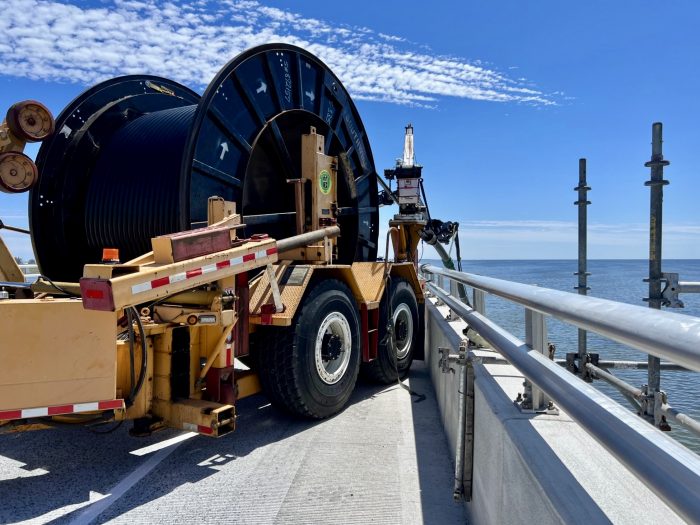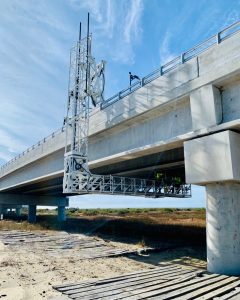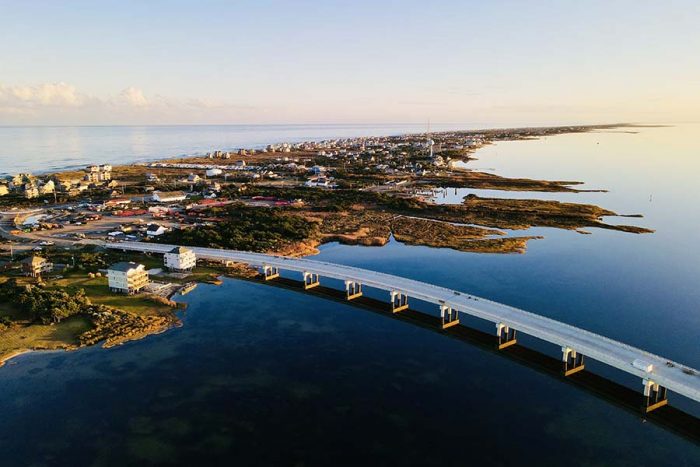
While the North Carolina Department of Transportation (NCDOT) recently began the final phase of the Jug Handle Bridge project – removing the pavement from a two-mile former section of N.C. Highway 12 – the Cape Hatteras Electric Cooperative (CHEC) also celebrated a corresponding milestone this week.
During the construction of the new bridge, CHEC was also hard at work to build a new conduit system located under the 2.4-mile-long structure, in order to move power from the overhead lines just north of Rodanthe.
As of this week, CHEC reports that all its work on the bridge is done, and testing has begun on the new conduit system to ensure that everything is running smoothly.
“Starting on Tuesday or Wednesday, there will be no more closures on the bridge by CHEC,” said Laura Ertle, Director of Public Relations and Marketing for CHEC. “Our lane closures will be wrapping up in the next couple of days.”

“The cable system is completely installed under the bridge, all the splicing has been complete, and the scaffolding has been removed from the bridge’s four splice boxes,” she added. “We will be testing the cables this week, and will be ready to put the [power] load on it soon.”
The power delivered to Hatteras and Ocracoke Islands is solely provided by the transmission lines that run parallel to N.C. Highway 12, and before the Jug Handle Bridge opened in July of 2022, that route included the stretch between Rodanthe and Pea Island that the new bridge now bypasses.
Because of this roadway shift, CHEC began work in December of 2021 to move the overhead transmission lines to a secure locale under the new bridge, with help from contractor New River Electrical, (and its subcontractor Aptus), to install the hanger, conduit, and cables under the structure.
Originally, the new under-bridge conduit system was expected to be complete and operational by February of 2023, but the work to move the power is finishing months ahead of schedule.
“One of the things that changed from when we first started this project is that NCDOT had asked us to suspend work in the summer months, so as not to interfere with summer traffic,” said Ertle. “Originally, we planned to work as much as possible until Memorial Day, and then return to work again on Labor Day.”
The problem with this original plan was that once the bridge was complete and open, and work to remove the old highway began, accessing the overhead lines in the bypassed stretch of the S-Curves would become difficult, especially during the height of hurricane season.

“We expressed some concern about road removal and accessing those [overhead] lines in the event of a hurricane or storm, so they graciously reworked the plan, and two things happened,” said Ertle. “The U.S. Fish and Wildlife Service agreed to delay the road removal for several months, and the NCDOT agreed to allow us to work in the summer months. That expedited the project a lot.”
The switch to the new power lines won’t officially occur until early November or early December. Minor power outages will likely be required, so an early November or December timeframe ensures that any outages won’t correspond with the busy Thanksgiving holiday.
“When we do the cutover, it will require some planned outages, but once we get the go-ahead, we’ll communicate with our [CHEC] membership so they’ll know what’s happening and what to plan for,” said Ertle. “It will be similar to the process [for the new lines under] the Basnight Bridge.”
In the meantime, the public can look forward to fewer lane closures on the Jug Handle Bridge, now that CHEC’s work is complete, as well as safer and more reliable power in the years and hopefully decades to come.
“This is definitely a significant investment in the reliability of service for Hatteras and Ocracoke Islands,” said Ertle. “This move takes away all risk of ocean overwash, salt contamination, and all of the problems that can happen in that vulnerable section of Hatteras Island.”
“It’s definitely going to be an enhancement, and this was a really big project to complete. Any project that involves bridges over water and electricity can be complicated, but we’re happy to see the finish line.”










